Mastering the SHL Tests – The Complete Guide
What are the SHL Tests?
SHL is one of the most popular providers of psychometric assessments used by employers and by leading companies and organisations, including Deutsche Bank, Jefferies, Amazon, and Freshfields Bruckhaus Deringer.
The SHL tests include a variety of pre-employment assessments designed to measure the range of skills and abilities required in the position you applied for, including: numerical reasoning, verbal reasoning, inductive reasoning, logical reasoning, problem-solving, decision-making, personality traits, and behavioural tendencies. This article illustrates some of the different types of SHL assessment questions, the challenges they present and ideas on how to conquer them in order to make the score you need to stay in the recruitment race for the jobs you want.
How to approach SHL Tests
The most important thing when preparing for the SHL tests is to know which test you are about to take and prepare precisely for it. Although general practice can help you sharpen the needed abilities, only an accurate simulation that mimics the real thing will give you the complete picture of what’s coming ahead – the test’s structure, types of questions, the difficulties that lie in each one, the time limit you will have, etc.
Free access to JobTestPrep for Oxford University students
If you are preparing for online recruitment assessments, Oxford University students can get 12 months free access to JobTestPrep via the Careers Service. The JTP sites provides advice and preparation materials for a very wide variety of online recruitment tests, including SHL General Ability (Verify G+) interactive and non-interactive, SHL opq32 personality assessment, as well as numerical, verbal, and logical reasoning.
SHL assessments
The following sections introduce the SHL assessments which are most commonly used for graduate recruitment in the UK, and are also reviewed in this short video.
https://www.youtube.com/embed/yAECE0GT3DA?si=BuSm7Y6nol5rBNPT
SHL General Ability (Verify G+)
Most candidates receive a set of tests, each focusing on a different ability. The most common test is the SHL General Ability, also called SHL Verify G+.
The test comes in two versions – interactive and non-interactive. Both versions are highly challenging because they require advanced cognitive skills in numerical and logical reasoning and the capacity to swiftly interpret data within stringent time constraints.
Though both versions assess the same competencies, they differ not only in their interactivity but also in other features:
|
Version |
Interactive |
Non-interactive (Multiple-Choice) |
|---|---|---|
|
No. of Questions |
24 |
Varies (approx. 30) |
|
Time Limit |
36 minutes |
36 minutes |
|
Adaptive |
Yes |
No |
|
Question Types |
Numerical – Tables and Graphs, Numerical Calculation, Number Ranges Inductive – Next in Series, Rules Combination, Alphanumeric Sequences Deductive – Scheduling (Schedule, Calendar), Ranking |
Numerical – Tables and Graphs Inductive – Next in Series Deductive – Seating Arrangements |
SHL Numerical Reasoning Question – Interactive
Using the given information, determine how many likes per day each post received and what percentage of the total likes was given to each.
Likes on Facebook
- Two net personalities shared posts on Facebook.
- The total number of likes for both posts increased by 15% from the first day to the second, reaching 575,000 likes on Day 2.
- Post B was given 150,000 likes on Day 1.
- The number of likes for Post B increased by 8% from day one to day two.
Answer the question by tweaking the following graph so that it reflects the correct information:
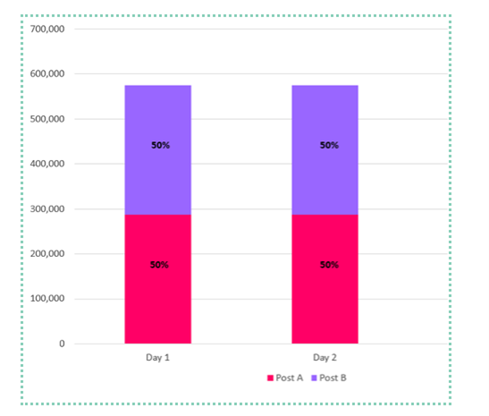
The correct division is –
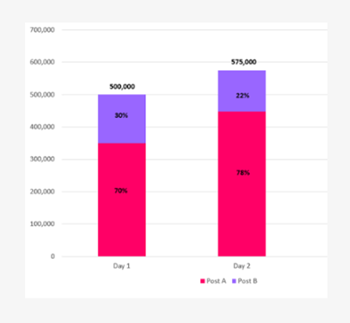
SHL Numerical Reasoning Question – Non-interactive
|
|
USD |
EUR |
GBP |
JPY |
CAD |
|---|---|---|---|---|---|
|
USD |
1 |
0.6944 |
0.6091 |
76.764 |
0.9556 |
|
EUR |
1.401 |
1 |
0.8764 |
110.512 |
1.3761 |
|
GBP |
1.64518 |
1.141 |
1 |
126.101 |
1.5701 |
|
JPY |
0.013 |
0.009 |
0.0079 |
1 |
0.0125 |
|
CAD |
1.0465 |
0.7267 |
0.6369 |
80.346 |
1 |
How many GBP can be purchased for 7500 CAD?
11.772 | 4776 | 477.7 | 8720 | 6369
7500 CAD*0.6369 = 4776.75 GBP.
This means you can buy 4776 GBP with 7500 CAD since you don't quite have enough CAD to buy 4777 GBP.
ANSWER: The correct answer is (B) – 4776
SHL Deductive Reasoning Question – Interactive:
- Anna – Must be in the office during 13th – 20th
- Lee – Is busy on Wednesdays, Thursdays, and Fridays
- Simon – Is free to join the trip every fourth day starting the 2nd, including weekends
- Greg – Is not occupied on Tuesdays and Wednesdays.
A team of employees is trying to schedule a day trip together the following month. Select all possible weekdays in the next month when all team members can join the trip.
Calendar
|
SUN |
MON |
TUE |
WED |
THU |
FRI |
SAT |
|---|---|---|---|---|---|---|
|
|
|
1 |
2 |
3 |
4 |
5 |
|
6 |
7 |
8 |
9 |
10 |
11 |
12 |
|
13 |
14 |
15 |
16 |
17 |
18 |
19 |
|
20 |
21 |
22 |
23 |
24 |
25 |
26 |
|
27 |
28 |
29 |
30 |
31 |
|
|
ANSWER: The correct answer is the 29th of the month.
SHL Deductive Reasoning Question – Non-interactive:
In a restaurant’s pantry there are seven kinds of fruits – Figs, Guavas, Honeydews, Kiwis, Mangos, Nectarines and Papayas. The restaurant’s chef has to pick exactly four different kinds of fruits out of the seven to make a fruit salad. The selected fruits must meet the following conditions:
- Papayas can be selected only if Kiwi is selected.
- Fig can be selected only if Nectarine is selected.
- Either Mango or Nectarine must be selected but not both.
- Either Papaya or Honeydew must be selected but not both.
Which of the following could be a complete and accurate list of the fruits from which the salad is made up?
- Kiwi, Papaya, Fig, Mango
- Kiwi, Nectarine, Honeydew, Guava
- Mango, Nectarine, Fig, Papaya
- Papaya, Mango, Guava, Honeydew
- Guava, Papaya, Kiwi, Fig
ANSWER: The Correct answer is (B) - Kiwi, Nectarine, Honeydew, Guava.
SHL Inductive Reasoning Question – Interactive:
Complete the following sequence:
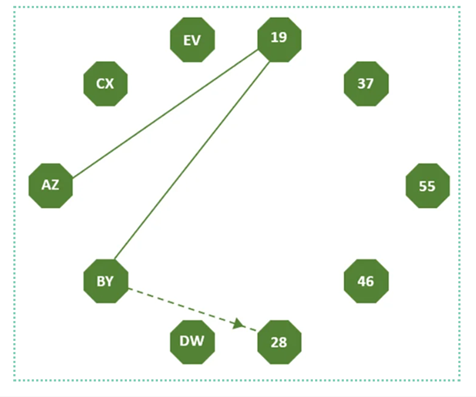
The question asks you to find the logical rules applied between these nodes and complete the sequence, which started with the connected nodes: AZ -> 19 -> BY -> 28.
Logical Rule #1: The sequence starts with a node containing letters, which connects to a node containing numbers, which then connects once again to a node containing letters. The final sequence will stick to this pattern: Letters -> Numbers -> Letters -> Numbers, and so forth.
Logical Rule #2: The main “theme” of this question is opposite extremes:
- A and Z are the first and last letters of the alphabet.
- 1 and 9 are the first and last digits in the base-10 system (excluding 0 which does not appear in the question).
With each connection, these letters and digits are ‘getting closer’ to each other:
- B and Y – are the second and the second-to-last letters of the alphabet.
- 2 and 8 – are the second and second-to-last digits (presented in this question).
Following these rules, the next nodes should be the third and fourth letters or digits.
Final answer: AZ -> 19 -> BY -> 28 -> CX -> 37 -> DW -> 46 -> EV -> 55
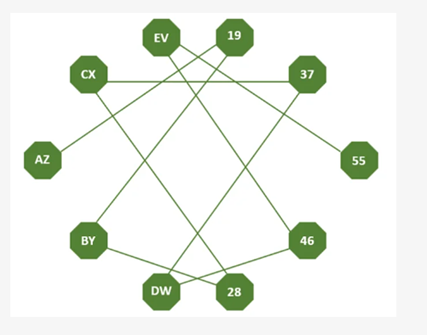
SHL Inductive Reasoning Question – Non-Interactive:
Which diagram would appear next in the series? A | B | C | D | E?
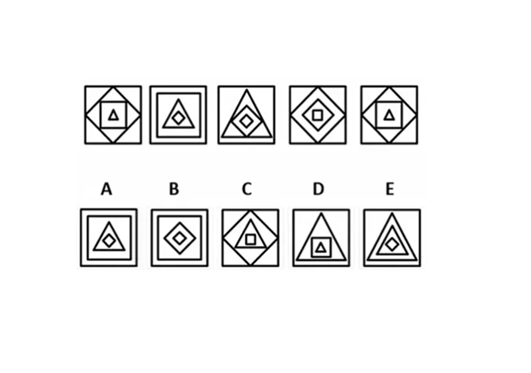
ANSWER: The correct answer is A.
SHL OPQ32 Personality Test
Recently, employers have been trying to make sure that their employees have not only the skills needed for the job but also the traits and behavioural tendencies that fit the organisation’s culture and environment. To do so, they use personality questionnaires, such as the SHL OPQ32.
As in the SHL ability tests, the OPQ32 also has several versions, and most contain 104 questions presented in sets of 3 or 4 statements. For each question, you are required to select one statement that closely represents you and another that describes you less accurately.
Let’s take a look:
- I am invested in other’s wellbeing. Most | Least
- I aspire to be ‘Number One’. Most | Least
- I feel very hopeful about the good things to come. Most | Least
The newest OPQ32 test version is more interactive and comprises two steps.
First, you will need to choose the statement that best describes you, referred to as the 'most’:
- I like to do things my own way
- I recognize weak arguments
- I take care of fellow procedures
Suppose you select the first statement (highlighted in bold). After choosing this statement, it vanishes from the screen, and you must then pick another statement from the remaining options that best describes you:
- I recognize weak arguments
- I take care of fellow procedures
SHL Verbal Reasoning Test
As its name suggests, this test assesses your verbal skills and ability to comprehend and evaluate written information.
The test has only a non-interactive version. You will have 30 questions to answer in 19 minutes.
Here is an example:
In the past few years, the government has turned to shock tactics to fight the battle against smoking and the burden smokers pose to the country’s economy – manifested in sick days and health issues. The latest anti-smoking campaign showed tumours growing from a cigarette. Needless to say, this advert was contentious. On the one hand, the advert has become a viral sensation since its launch and has attracted plenty of attention to the subject. The government estimates that approximately 300,000 people will attempt to quit smoking because of the campaign. On the other hand, some argue that using a hard-hitting approach is not the best way because people become very afraid. If someone thinks they might have cancer or a symptom of cancer, they’re likely to push it out of their mind. Health experts claim the new campaign is not effective in targeting all smokers and recommend using it alongside other measures.
The advertisement is not effective because it scares people.
True | False | Cannot Say
ANSWER: Cannot Say
The passage presents two opposite approaches of pros and cons to the anti-smoking campaign.
SHL Situational Judgement Tests
SJT (Situational Judgement Test) is a psychological assessment tool that evaluates work-related behaviours and preferences.
SHL offers two versions of SJTs, one for graduates and one for managerial roles.
The Graduate SJT includes 10 workplace scenarios, each followed by 4-7 responses that need to be rated based on their desirability. In total, there are 70 questions to answer, typically taking around 25 minutes.
The Managerial SJT includes 14 workplace scenarios, each with 5-9 response options to be rated for desirability. This test consists of 100 questions and generally takes approximately 40 minutes.
Let’s see a SJT Graduate question:
You’ve been working in the same place for the past three years and have managed to work your way up. Lately, you have been feeling you have reached your potential in the company, so you pursue options for advancing your career in other companies. You are now in negotiations for a new position.
Rumours are you are leaving have spread in your workplace.
Response #1: Since the rumour is out, confirm your intention to anyone who asks if you are in the midst of negotiations for a new position.
1 | 2 | 3 | 4 | 5
Response #2: Because the rumour is out, you update your manager and only them about your intention to leave. Since you are still an employee there, you keep working normally.
1 | 2 | 3 | 4 | 5
Response #3: Since the rumour is out, and you will probably leave, you invest a little less in your work and more in attaining the new position.
1 | 2 | 3 | 4 | 5
Response #4: Since it is only a rumour, you update no one until you hand in your notice. Nothing has been decided yet.
1 | 2 | 3 | 4 | 5
Response #5: Inform your manager about your intentions to leave but deny this to anyone else who asks, as your resignation has not been confirmed yet.
1 | 2 | 3 | 4 | 5
This article was written by Rona Strauss, JobTestPrep’s expert on the SHL tests.
Feel free to contact Rona at ask_the_team@jobtestprep.co.uk




